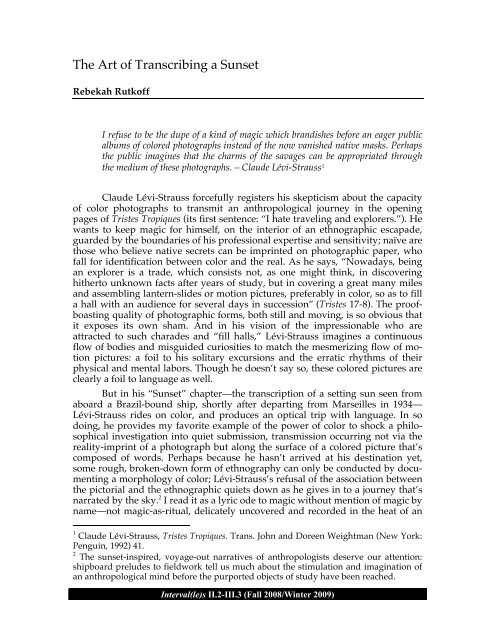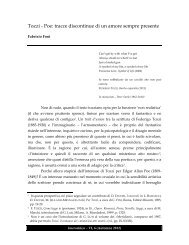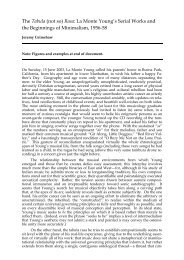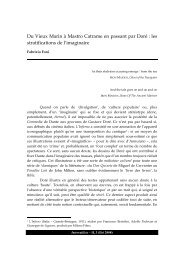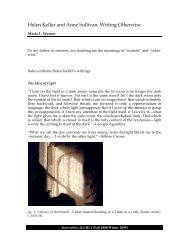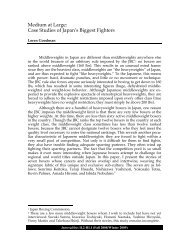The Art of Transcribing a Sunset
The Art of Transcribing a Sunset
The Art of Transcribing a Sunset
You also want an ePaper? Increase the reach of your titles
YUMPU automatically turns print PDFs into web optimized ePapers that Google loves.
<strong>The</strong> <strong>Art</strong> <strong>of</strong> <strong>Transcribing</strong> a <strong>Sunset</strong><br />
Rebekah Rutk<strong>of</strong>f<br />
I refuse to be the dupe <strong>of</strong> a kind <strong>of</strong> magic which brandishes before an eager public<br />
albums <strong>of</strong> colored photographs instead <strong>of</strong> the now vanished native masks. Perhaps<br />
the public imagines that the charms <strong>of</strong> the savages can be appropriated through<br />
the medium <strong>of</strong> these photographs. – Claude Lévi-Strauss 1<br />
Claude Lévi-Strauss forcefully registers his skepticism about the capacity<br />
<strong>of</strong> color photographs to transmit an anthropological journey in the opening<br />
pages <strong>of</strong> Tristes Tropiques (its first sentence: “I hate traveling and explorers.”). He<br />
wants to keep magic for himself, on the interior <strong>of</strong> an ethnographic escapade,<br />
guarded by the boundaries <strong>of</strong> his pr<strong>of</strong>essional expertise and sensitivity; naïve are<br />
those who believe native secrets can be imprinted on photographic paper, who<br />
fall for identification between color and the real. As he says, “Nowadays, being<br />
an explorer is a trade, which consists not, as one might think, in discovering<br />
hitherto unknown facts after years <strong>of</strong> study, but in covering a great many miles<br />
and assembling lantern-slides or motion pictures, preferably in color, so as to fill<br />
a hall with an audience for several days in succession” (Tristes 17-8). <strong>The</strong> pro<strong>of</strong>boasting<br />
quality <strong>of</strong> photographic forms, both still and moving, is so obvious that<br />
it exposes its own sham. And in his vision <strong>of</strong> the impressionable who are<br />
attracted to such charades and “fill halls,” Lévi-Strauss imagines a continuous<br />
flow <strong>of</strong> bodies and misguided curiosities to match the mesmerizing flow <strong>of</strong> motion<br />
pictures: a foil to his solitary excursions and the erratic rhythms <strong>of</strong> their<br />
physical and mental labors. Though he doesn’t say so, these colored pictures are<br />
clearly a foil to language as well.<br />
But in his “<strong>Sunset</strong>” chapter—the transcription <strong>of</strong> a setting sun seen from<br />
aboard a Brazil-bound ship, shortly after departing from Marseilles in 1934—<br />
Lévi-Strauss rides on color, and produces an optical trip with language. In so<br />
doing, he provides my favorite example <strong>of</strong> the power <strong>of</strong> color to shock a philosophical<br />
investigation into quiet submission, transmission occurring not via the<br />
reality-imprint <strong>of</strong> a photograph but along the surface <strong>of</strong> a colored picture that’s<br />
composed <strong>of</strong> words. Perhaps because he hasn’t arrived at his destination yet,<br />
some rough, broken-down form <strong>of</strong> ethnography can only be conducted by documenting<br />
a morphology <strong>of</strong> color; Lévi-Strauss’s refusal <strong>of</strong> the association between<br />
the pictorial and the ethnographic quiets down as he gives in to a journey that’s<br />
narrated by the sky. 2 I read it as a lyric ode to magic without mention <strong>of</strong> magic by<br />
name—not magic-as-ritual, delicately uncovered and recorded in the heat <strong>of</strong> an<br />
1<br />
Claude Lévi-Strauss, Tristes Tropiques. Trans. John and Doreen Weightman (New York:<br />
Penguin, 1992) 41.<br />
2<br />
<strong>The</strong> sunset-inspired, voyage-out narratives <strong>of</strong> anthropologists deserve our attention:<br />
shipboard preludes to fieldwork tell us much about the stimulation and imagination <strong>of</strong><br />
an anthropological mind before the purported objects <strong>of</strong> study have been reached.<br />
Interval(le)s II.2-III.3 (Fall 2008/Winter 2009)
768<br />
Interval(le)s II.2-III.3 (Fall 2008/Winter 2009)<br />
Rebekah Rutk<strong>of</strong>f<br />
inaccessible jungle, but magic in its most modest, culturally neutral state: as a<br />
picture <strong>of</strong> change.<br />
<strong>The</strong> vision <strong>of</strong> a complete performance with so many rapidly dissolving<br />
acts, the surprise <strong>of</strong> finding the gaudy, neon and jewel-toned in the daily, and the<br />
drive to narrate the spectacle in detail combine to momentarily topple Lévi-<br />
Strauss’s pr<strong>of</strong>essional sense <strong>of</strong> identification. He no longer needs anthropology;<br />
or, anthropology for a moment is contained in the joint beholding and transcription<br />
<strong>of</strong> a sunset: “If I could find a language in which to perpetuate those appearances,<br />
at once so unstable and so resistant to description, if it were granted to me<br />
to be able to communicate to others the phases and sequences <strong>of</strong> a unique event<br />
which would never recur in the same terms, then…I should in one go have<br />
discovered the deepest secrets <strong>of</strong> my pr<strong>of</strong>ession” (Tristes 62). His language in this<br />
chapter jumps out <strong>of</strong> the skin <strong>of</strong> its usual container; he stretches for the words to<br />
mark his vision <strong>of</strong> the sky and rushes to include it all in eight pages <strong>of</strong> sunsethypnosis.<br />
He sees “bloated but ethereal ramparts, all glistening, like mother <strong>of</strong><br />
pearl, with pink, mauve and silvered gleams,” then a “laminated [mass] like a<br />
sheet <strong>of</strong> metal illuminated from behind, first by a golden, then a vermillion, then<br />
a cherry glow”; there are “bulging pyramids and frothy bubblings” and “streaks<br />
<strong>of</strong> dappled blondness decomposing into nonchalant twists” and a “spun glass<br />
network <strong>of</strong> colors…shrimp, salmon, flax, straw” that, with the final setting, becomes<br />
“purple, then coal black, and then…no more than an irregular charcoal<br />
mark on grainy paper” as night finally arrives (Tristes 62-9). And then he returns<br />
to being an anthropologist, making his way through South America without the<br />
accompaniment <strong>of</strong> a painted sky. He returns to being a structuralist, a writer, and<br />
to black and white.<br />
As evidenced by Lévi-Strauss’s pr<strong>of</strong>essional un-doing in its midst, the<br />
sunset is a zone <strong>of</strong> reversal. <strong>The</strong> day trades places with the night, and announces<br />
the turn-over with paint and time; it’s a rare site <strong>of</strong> ocular access to x becoming y<br />
in a temporal register that’s both fast and slow (fast enough for the entire morphology<br />
to unfold in one sitting, slow enough to note and record each transition).<br />
When water is part <strong>of</strong> the tableau, the identities <strong>of</strong> sea and sky break down too—<br />
the shapes <strong>of</strong> clouds and spills <strong>of</strong> pink and purple pass back and forth. And as<br />
the stream <strong>of</strong> his documentation unfolds, Levi Strauss’s use <strong>of</strong> figurative language<br />
collects around another kind <strong>of</strong> reversal: the turning <strong>of</strong> the sky is linked to<br />
forms <strong>of</strong> art, and the comparative leap that characterizes metaphor finds in the<br />
sky the artifacts <strong>of</strong> culture. “Daybreak is a prelude, the close <strong>of</strong> day an overture<br />
which occurs at the end instead <strong>of</strong> the beginning, as in old operas” (Tristes 62). In<br />
a double back and forth, he notates clouds “immobilized in the form <strong>of</strong> mouldings<br />
representing clouds, but which real clouds resemble when they have the<br />
polished surface and bulbous relief <strong>of</strong> carved and gilded wood” (Tristes 64). And<br />
in the end, the scene is a “photographic plate <strong>of</strong> night” (Tristes 68).<br />
Although Lévi-Strauss does not invoke “magic” in his sunset reverie, its<br />
presence hovers. For magic in its essence runs on the surprise and gratification <strong>of</strong><br />
encounters with condensed, sped-up forms <strong>of</strong> change, foils to the durations by<br />
which changes <strong>of</strong> state—in material form and psychic interiority—take place in<br />
non-magical life. Magic <strong>of</strong>fers a display <strong>of</strong> its own effectivity, turning abstract<br />
ideas into objects. In A General <strong>The</strong>ory <strong>of</strong> Magic, Marcel Mauss tells <strong>of</strong> a Murring
<strong>The</strong> <strong>Art</strong> <strong>of</strong> <strong>Transcribing</strong> a <strong>Sunset</strong><br />
sorcerer, for instance, who produces chunks <strong>of</strong> quartz from his mouth as pro<strong>of</strong> <strong>of</strong><br />
a nocturnal encounter with the spirit world. 3 But as Mauss crisscrosses content,<br />
geography and time, reviewing demonology, rites and role-acquisition in Australia,<br />
Madagascar, and Malaysia at ancient, medieval and contemporary moments,<br />
he is most interested in language; he remains a spectator who gets to use<br />
logical language and watch its illogical applications at once—the ideal position,<br />
perhaps, <strong>of</strong> the anthropologist. Mauss boils magic down to its core: “<strong>The</strong> magician<br />
knows that his magic is always the same—he is always conscious <strong>of</strong> the fact<br />
that magic is the art <strong>of</strong> changing” (General 75). And again: “Between a wish and<br />
its fulfillment there is, in magic, no gap…. [M]agic’s central aim is to produce<br />
results” (General 78-9). In response to criticism leveled against Mauss for drawing<br />
generalizations from such diverse examples, Lévi-Strauss re-framed Mauss’s<br />
move as the seed <strong>of</strong> a radical semiotic observation: magic is a turning <strong>of</strong> the mismatches<br />
<strong>of</strong> language into useful material; it takes the peripheral excess (outside<br />
logic, but hovering, waiting for attention) and allows it to motor and fuel the activities<br />
<strong>of</strong> change. 4 As David Pocock explains in his “Foreward” to Mauss’s<br />
General <strong>The</strong>ory: “Rituals do what words cannot say: in act black and white can be<br />
mixed; the young man is made an adult; spirit and man can be combined or<br />
separated at will” (5).<br />
<strong>The</strong> idea that a photo could not only stand in for a mask, but also carry the<br />
mask’s contexts, auras and the anthropologist’s hard-earned understanding <strong>of</strong> it,<br />
is for Lévi-Strauss an unbearable shortcut. Photography is a variety <strong>of</strong> magic that<br />
he “refuse[s] to be the dupe <strong>of</strong>.” In contrast, in his beholding and written<br />
tracking <strong>of</strong> the sunset, Lévi-Strauss finds a way to stay with the stream <strong>of</strong> his<br />
consciousness without break—the sunset holds his perception and reverie, contains<br />
and is coextensive with it: the sunset functions doubly, as any satisfying<br />
magical event does, as object and stream.<br />
*<br />
An overwhelming number <strong>of</strong> videos made by the French-born American<br />
artist Michel Auder (b. 1944) feature sunsets: Brooding Angels (1988), Personal<br />
Narrative <strong>of</strong> Travels to Bolivia (1995), Polaroid Cocaine (1993), Ro<strong>of</strong>tops and Other<br />
Scenes (1996), TV America (1988), Voyage to the Center <strong>of</strong> the Phone Lines (1993), and<br />
others. A sunset and a videotape are somehow meant to commune: the furriness<br />
<strong>of</strong> the tableau <strong>of</strong> a dropping sun; the temporariness; the bleeding colors, pale and<br />
florescent at once, tending toward gradation and chiaroscuro; and the strange<br />
impossibility <strong>of</strong> their location in the sky—all find ideal recognition among<br />
televisual tubes and scan lines and their chromatic tendencies. Video is prone to<br />
disappointment in a variety <strong>of</strong> directions. It degrades with ease, can produce<br />
unsolicited clarity, stubbornly refusing mystery, and it fails to behave and gratify<br />
like film. But when it finds its proper objects and gestures under the auspices <strong>of</strong><br />
the right light, a poem is made. Auder once told me that making videos feels like<br />
working with language: like writing.<br />
3<br />
Marcel Mauss, A General <strong>The</strong>ory <strong>of</strong> Magic. Trans. Robert Brain (New York: Routledge,<br />
2001) 50-51.<br />
4<br />
David Pocock, “Foreward,” A General <strong>The</strong>ory <strong>of</strong> Magic 4-8.<br />
Interval(le)s II.2-III.3 (Fall 2008/Winter 2009)<br />
769
770<br />
Interval(le)s II.2-III.3 (Fall 2008/Winter 2009)<br />
Rebekah Rutk<strong>of</strong>f<br />
In Voyage to the Center <strong>of</strong> the Phone Lines, Auder holds dissociated and urgent<br />
time side-by-side for 55 minutes. He has gathered, selected and ordered<br />
fragments <strong>of</strong> intercepted phone conversations (he obsessively scanned mobile<br />
calls between 1987 and 1989) for his audio track and placed them on top <strong>of</strong><br />
slowly alternating, gazed-out-at images from a quiet beach retreat. Many images<br />
frame some combination <strong>of</strong> sea, sky and horizon line—<strong>of</strong>ten fringed by the<br />
silhouettes <strong>of</strong> tree tips and leaf edges—at alternating moments <strong>of</strong> daytime and<br />
sunset, noontime azure expanses and evening tableaux <strong>of</strong> the sinking sun existing<br />
side by side. <strong>The</strong> shots are devoid <strong>of</strong> human figures, and there’s a suggestion<br />
that the pictures were generated out <strong>of</strong> solitude, perhaps spurred on by<br />
notes <strong>of</strong> engaged malaise. Rain falls on bricks; seagulls fly across the water;<br />
beads <strong>of</strong> water rest on pine-needle tips; a daytime moon hangs in the sky. Auder<br />
is not lost in the wilderness, however: in the second half <strong>of</strong> the video we encounter<br />
a beach house interior with a fireplace, car racing on TV, and windows<br />
through which to continue to watch the sky.<br />
<strong>The</strong> pairs <strong>of</strong> voices from the phone calls are common and raw—the<br />
content is not always alarming but the sameness that binds them is: these conversations<br />
are marked by intimate and incisive stabs at the truth, and many <strong>of</strong> them<br />
by urgent concerns about sexuality and sanity. Lovers anticipate sex and taunt<br />
each other with guesses about who loves the other more; parents fret over their<br />
teenage daughter’s tendency toward unprotected sex with an unsavory boy and<br />
fantasize about forms <strong>of</strong> violent punishment; two female friends make distinctions<br />
among kinds <strong>of</strong> sex with types <strong>of</strong> men; two men wonder how to re-engage<br />
an emotionally withdrawing girlfriend; a woman describes feeling acutely rejected<br />
by a boyfriend who’s not keen on sex; two friends criticize a third for<br />
cutting <strong>of</strong>f all contact with her mother and calling it bravery. <strong>The</strong>re are questions<br />
about masturbation and molestation and therapy and the ethics <strong>of</strong> skipping a<br />
birthday party, and about how to best praise God and gain membership to his<br />
kingdom.<br />
It’s not enough, though, to call Michel Auder a “voyeur”—the term most<br />
<strong>of</strong>ten used to explain what’s undeniably and uncannily fascinating about his<br />
work. <strong>The</strong> tag <strong>of</strong> “voyeur” stems logically from the artist’s tendency to capture<br />
images from angles <strong>of</strong> silent, secret or furtive observation, as well as from the fact<br />
that his biography and body <strong>of</strong> work are full <strong>of</strong> well-inscribed proper names—<br />
Viva, Cindy Sherman, Alice Neel, to name a few—and hence many <strong>of</strong> his videos<br />
<strong>of</strong>fer the viewer a kind <strong>of</strong> ethnographic access to some <strong>of</strong> the many art-worlds in<br />
which Auder has worked and lived. But this tag is <strong>of</strong> little use in the effort to<br />
fully encounter and articulate the poetics and rhetorical acrobatics <strong>of</strong> Auder’s<br />
work, which spans four decades and many hundreds <strong>of</strong> tapes.<br />
Yes, Auder is certainly listening in in Voyage—but his voyeurism goes way<br />
beyond the perversely motivated acts <strong>of</strong> observation that we associate with the<br />
term. I see Auder-as-voyeur collecting in order to confirm a suspicion, intervening<br />
in the streams <strong>of</strong> talk that contain everything we might ever want to know. It<br />
requires great labor to collect the scripts <strong>of</strong> one’s own thought, and even more to<br />
collect those <strong>of</strong> strangers and reformulate them into an object <strong>of</strong> some kind—a<br />
video.
<strong>The</strong> <strong>Art</strong> <strong>of</strong> <strong>Transcribing</strong> a <strong>Sunset</strong><br />
I can’t watch Voyage to the Center <strong>of</strong> the Phone Lines without thinking <strong>of</strong><br />
William James’s “Stream <strong>of</strong> Thought” essay from his 1890 Principles <strong>of</strong> Psychology:<br />
a proposal that thought is not made <strong>of</strong> starts and stops and discrete ideas but is<br />
instead continuous, interruption-free, and ever-changing (“we never descend<br />
twice into the same stream”). <strong>The</strong> sole place James does assert a gap—“the greatest<br />
breach in nature”—is between individual minds:<br />
<strong>The</strong> only states <strong>of</strong> consciousness that we naturally deal with are found in<br />
personal consciousnesses, minds, selves, concrete particular I’s and you’s.<br />
Each <strong>of</strong> these minds keeps its own thoughts to itself. <strong>The</strong>re is no giving or<br />
bartering between them. No thought even comes into direct sight <strong>of</strong> a<br />
thought in another personal consciousness than its own. Absolute insulation,<br />
irreducible pluralism, is the law. 5<br />
<strong>The</strong> implicit charge is that this breach is so pr<strong>of</strong>ound that we misperceive<br />
it in every place but the one where it actually exists—we treat it as occurring<br />
between and among thoughts and days and objects, and we value associated<br />
gestures <strong>of</strong> articulation, enunciation and concision. James doesn’t ask us to<br />
banish the recognition <strong>of</strong> separate objects and moments <strong>of</strong> thought, but simply to<br />
view them in the context both <strong>of</strong> the “greatest breach” between minds and <strong>of</strong> the<br />
ceaseless stream within a single one. In Voyage, like so many <strong>of</strong> Auder’s videos,<br />
there is both bleeding—between day and night, water and sky, and among the<br />
private pains <strong>of</strong> strangers—and the satisfying static <strong>of</strong> switching channels as we<br />
leave the stream <strong>of</strong> one conversation and enter the current <strong>of</strong> another.<br />
*<br />
Shots <strong>of</strong> sunsets in Voyage punctuate the video with a kind <strong>of</strong> focus and<br />
straightforward shock that mimic the urgency <strong>of</strong> these lovers and relatives and<br />
friends. Each finds the setting sun in a pose <strong>of</strong> distinct gesture and coloration (it<br />
is unclear if the images come from a single night or were collected from many).<br />
<strong>The</strong> water is black; a neon pink halo surrounds the sun; the sky is striped by<br />
yellow and green strokes; the setting sun shrinks in a turquoise sky over navy<br />
water; lavender, fuchsia and peach gradations float above a dark purple sea.<br />
Each shot is startling for its difference from the others, and for the spectrum <strong>of</strong><br />
coloration that’s so unlike the pared-down palettes <strong>of</strong> the day-time shots. <strong>The</strong><br />
night tells secrets. <strong>The</strong> speakers tell secrets too—not so much to each other as to<br />
us—because they are neither meant for us nor for assembly alongside those <strong>of</strong><br />
the other callers.<br />
<strong>The</strong> secret is both that we’re all having versions <strong>of</strong> the same conversations<br />
and that culture provides few ways for us to know and encounter this fact. <strong>The</strong><br />
secret is that we need transcripts from the stream <strong>of</strong> thought and from the flow <strong>of</strong><br />
talk for our own experiences <strong>of</strong> health and communion. Sexuality is urgent and<br />
confused. Women speak <strong>of</strong> the workings <strong>of</strong> desire with certainty among themselves—and<br />
invoke knowing these things less surely with a male lover. We‘ve<br />
heard <strong>of</strong> these dilemmas before, but we don’t know them in this form, all at once<br />
and from the mouths <strong>of</strong> strangers.<br />
5 William James, “Stream <strong>of</strong> Thought,” Principles <strong>of</strong> Psychology (Cambridge: Harvard UP,<br />
1981) 221.<br />
Interval(le)s II.2-III.3 (Fall 2008/Winter 2009)<br />
771
772<br />
Interval(le)s II.2-III.3 (Fall 2008/Winter 2009)<br />
Rebekah Rutk<strong>of</strong>f<br />
Woman: People who are not God’s children are going to be blinded.<br />
Man: But it’s also up to us to bring as many into the flock as we can. We have to<br />
listen to people. I pray that he gives me time to do that…<br />
Woman: God is good—he answers prayers, but we have to really keep in touch<br />
with him; it’s a two-way street.<br />
Man: I read the Bible everyday. I speak the Word every single day when I do<br />
have time. That’s kinda hard sometimes.<br />
Woman: God doesn’t expect more than what you can do—he knows, but you can<br />
lift your thoughts up to him. Just your thoughts.<br />
Man: I try to be still before the Lord and I try to tune into what he has to say…<br />
Woman 1: I don’t want it to be like we’re gonna get together and go to bed...<br />
Woman 2: You know what happens, when you have so little time together, that’s<br />
what ends up happening.<br />
Woman 1: And I don’t like that. I want there to be some substance…quite frankly<br />
to me, that’s kind <strong>of</strong> boring…<br />
Woman 2: When I was going out with Russell, I felt like I was fucking dessert at<br />
the end <strong>of</strong> every night...<br />
Woman 1: I’m trying to learn you shouldn’t be insulted by that, but it’s like, I<br />
don’t want to be this object that gets fucked.... It’s like, hello? I’d rather just<br />
cuddle up with a guy…<br />
Woman 2: Oh, I love to cuddle. For me that’s even better.<br />
Woman 1: Oh yeah, I love that...<br />
Woman 2: I just like guys that make me melt. Oh, God.<br />
Woman 1: [X] made me very responsive to him because he was very caressing,<br />
and he wasn’t rough. It was like he cared about your body.
<strong>The</strong> <strong>Art</strong> <strong>of</strong> <strong>Transcribing</strong> a <strong>Sunset</strong><br />
Daughter: Mama wants to know if it’s convenient for you to talk to him?<br />
Father: Talk to her?<br />
Daughter: Yeah. Alright ‘cause there’s something she’s gotta tell you…<br />
Father: Is it about you?<br />
Daughter: Yeah.<br />
Father: What is it now?<br />
Daughter: You’re gonna be disappointed but it’s something.<br />
Father: Don’t tell me you saw Billy again.<br />
[…]<br />
Father: I think there’s something radically wrong with her.<br />
Mother: You don’t know the worst <strong>of</strong> it. She’s been sleeping with him. She slept<br />
with him last night.<br />
Father: What do you mean she slept with him last night?<br />
Mother: She’s not been using protection and mind you he’s been sleeping with<br />
every Tom, Dick and Harry.<br />
[…]<br />
Mother: I think you need to keep a tighter rein on her, Jack…<br />
Father: I’m gonna beat the shit out <strong>of</strong> her if she lied to me. I’m just forewarning<br />
you. I don’t give a fuck how old she is. She’s gonna feel the back <strong>of</strong> my hand.<br />
Mother: Don’t hit her on the face.<br />
Woman: Think about this—my father supposedly according to Uncle Morgan<br />
was sexually abused more than anyone else.<br />
Man: That’s what I understand as well.<br />
Woman: What if my father did it to Garth and we don’t know?<br />
Man: That somehow would not surprise me.<br />
Woman: How do we find out?<br />
[…]<br />
Woman: How about masturbation?<br />
Man: Masturbation is a big question. Lots <strong>of</strong> kids masturbate.<br />
Woman: I know that, Philip, but they don’t do it in the TV room on 8 th Avenue in<br />
front <strong>of</strong> Pat and my mother at 3 years old…<br />
Man: Something is very, very, very wrong.<br />
In Voyage, Auder <strong>of</strong>fers us rare samples from the chaos <strong>of</strong> spoken<br />
language. <strong>The</strong> video seems like a direct response to the question Wallace Stevens<br />
poses in the first stanza <strong>of</strong> “A Fading <strong>of</strong> the Sun”:<br />
Interval(le)s II.2-III.3 (Fall 2008/Winter 2009)<br />
773
774<br />
Who can think <strong>of</strong> the sun costuming clouds<br />
When all people are shaken<br />
Or <strong>of</strong> night endazzled, proud,<br />
When people awaken<br />
And cry and cry for help? 6<br />
All images come from Michel Auder’s Voyage to the Center <strong>of</strong> the Phone Lines<br />
Interval(le)s II.2-III.3 (Fall 2008/Winter 2009)<br />
Rebekah Rutk<strong>of</strong>f<br />
6 Wallace Stevens, “A Fading <strong>of</strong> the Sun,” Wallace Stevens Collected Poetry and Prose. Ed.<br />
Frank Kermode and Joan Richardson (New York: Library Classics <strong>of</strong> the United States,<br />
Inc., 1997) 112-113.


